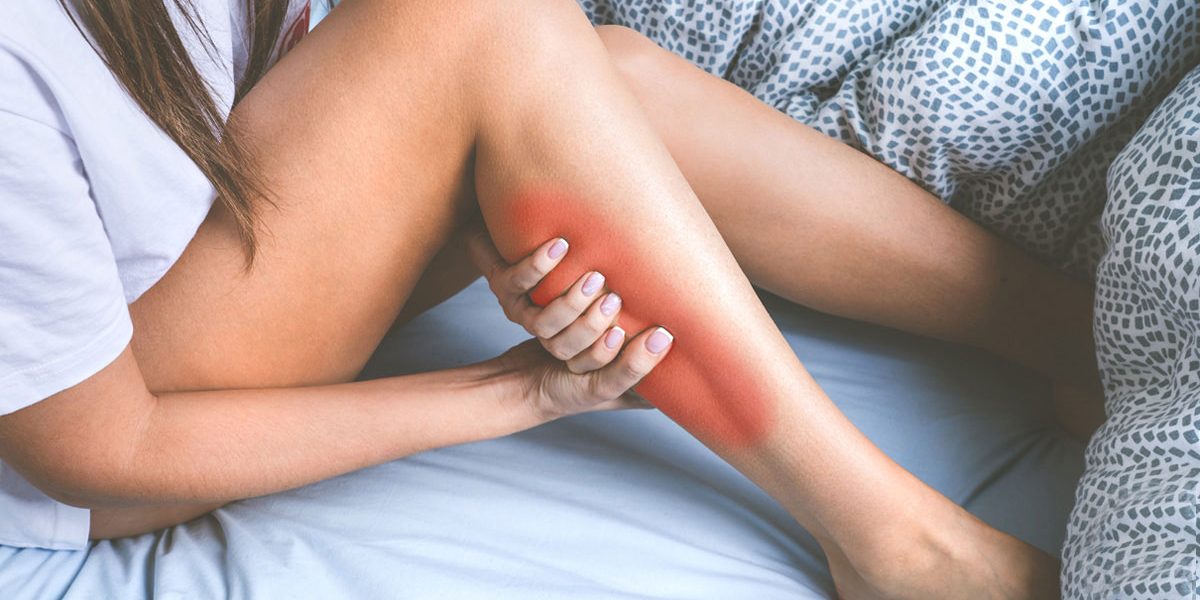Are you frequently jolted awake by the pain and agony of night time leg cramps? You’re not alone; a substantial number of adults share the night time leg cramps experience. In this guide on the various causes of leg cramps, and how you can treat and remedy it, I’ll unpack the top 12 causes of leg cramps at night, and a bonus 2 more you should be aware that most people do not know.
And it wouldn’t be fair to leave you hanging without 5 popular ways to prevent and treat leg and calf cramps recommended by physical therapists. But first lets start with some basics.
What are leg cramps?
Leg cramps are characterized by sudden and intense muscle contractions that can last for several seconds to minutes. These cramps typically target the calf and foot but can also affect the hamstring.
Leg and calf cramps involve a sudden and sustained contraction or tightening of a muscle, often referred to as a ‘charley horse.’
While leg cramps are a common experience, they tend to become more prevalent after the age of 50. Anatomically, these cramps involve an intense and spontaneous muscle contraction that is short-lived, lasting for a few seconds to minutes. However, once the cramp subsides, the affected muscle may feel sore for a few days.
Despite their common occurrence, there is no single definitive cause of leg cramps. There exists various opinions on the cause of leg cramps, however the true cause remains unknown. Doctors highlights that three out of four leg cramps occur at night, prompting exploration into the factors contributing to this evening phenomenon and the reasons behind waking up in pain.
1. Not Stretching Enough
In our busy lifestyle, marked by long periods of sitting and reduced physical activity, our grand parents practice of squatting, which naturally stretches leg tendons and muscles, has become obsolete.
The lack of this natural stretch to stretch the leg and calf may lead to increased muscle tightness and a higher susceptibility to cramps.
Incorporating regular stretching exercises into your routine becomes paramount to counteract the effects of our sedentary habits, and doesn’t hurt to keep a calf stretcher next to bed or in the family room to weave in a few squats when you wake up, or before plopping down on the couch for another evening of Breaking Bad.
2.Awkward Sleeping Positions
The position in which you sleep can significantly impact the occurrence of leg and calf cramps. When lying face down, especially with the foot in a plantar flexion position (toes pointing away), the calf muscles may shorten, setting the stage for cramps.
Opting for side-sleeping or positions that maintain neutral toe positioning reduces the strain on the calf muscles, potentially alleviating this cause of nocturnal cramping.
3. Changing Seasons
Surprisingly, research reveals a seasonal pattern in the frequency of nighttime leg cramps and calf pain, with higher occurrences in the summer months.
While not a universal truth, this pattern is attributed to potential nerve-related issues rather than muscular disorders. The summer’s increased vitamin D levels, resulting from sun exposure, may spur accelerated neural repair, potentially triggering cramps.
Understanding this seasonality can aid in implementing preventive measures during peak periods.
4. Lack of Fluids (Dehydration)
Hydration emerges as a crucial factor in preventing nocturnal cramps. A clear seasonal pattern is evident, with higher cramp frequencies in summer and lower occurrences in winter.
This correlation suggests a potential influence of heat and fluid balance on cramp development. Dehydration can disrupt electrolyte balance in the blood, making it essential to maintain adequate hydration levels, especially during warmer seasons or periods of intense physical activity.
5. Intense Workouts
Engaging in vigorous exercise has long been associated with muscle cramps. Ask any athlete or fitness guru and they’ll tell you the same, and the importance to weaving calf stretching and squats into their warm up workouts.
Highly trained athletes also experience cramps due to skeletal muscle overload and fatigue. The localized nature of these cramps in overworked muscle fibers emphasizes the importance of managing muscle exertion.
While hydration and stretching prove beneficial, preventing overuse cramps remains a nuanced challenge in physical fitness.
6. Tight Muscles
Tight and stiff muscles, often a consequence of inadequate stretching, exercise without proper warm-up, or overworking specific muscle groups, contribute significantly to the occurrence of leg cramps.
A proactive approach to muscle flexibility through regular stretching and warm-up routines is essential in preventing cramps resulting from muscular tightness.
7. Nutrient Deficiency
Mineral deficiency, particularly in calcium, magnesium, and potassium, emerges as a prominent cause of leg cramps.
While studies present mixed evidence, acknowledging the role of these electrolytes in maintaining fluid balance in the blood and muscles is crucial.
A balanced diet rich in sources like beans, nuts, whole grains, and leafy greens becomes imperative to address potential nutrient deficiencies.
8. Prolonged Standing
Individuals with occupations requiring prolonged periods of standing, such as desk jobs or roles that entail minimal movement, are more susceptible to leg cramps.
The accumulation of blood and fluid in the lower body during extended standing may lead to fluid imbalances, muscle shortening, and increased vulnerability to cramping. Implementing strategies to incorporate movement and alleviate prolonged static postures becomes essential in preventing these cramps.
9. Medications
Certain medications, such as diuretics and specific asthma drugs, have been identified as potential contributors to an increased risk of nocturnal leg cramps.
Diuretics, commonly used to treat high blood pressure, may induce electrolyte imbalances, while long-acting beta-adrenoceptors (LABAs) used in asthma medications could have stimulatory effects on motor neurons and receptors, potentially promoting cramping.
Awareness of medication-induced risks is crucial for individuals on these prescriptions, necessitating proactive measures to mitigate cramp occurrences.
10. Pregnancy
Pregnant women often experience more frequent leg cramps, attributed to factors like weight gain and disrupted circulation.
The physiological changes during pregnancy, coupled with the pressure exerted by the growing fetus on blood vessels and nerves, contribute to the heightened prevalence of nocturnal leg cramps.
Recognizing this association allows expectant mothers to implement preventive measures, including adequate hydration and nutritional support, to alleviate cramp frequency.
11. Health Conditions
Underlying health conditions, such as diabetes, hypertension, arthritis, neurological diseases, and depression, present additional risk factors for leg cramping.
Some conditions, including diabetes and neurological diseases, may disrupt or damage nerves, contributing to cramping. Medications prescribed for these conditions may also influence cramp development.
A holistic approach to managing these health conditions, coupled with targeted interventions, becomes pivotal in addressing leg cramps.
12. Aging
Aging introduces a multifaceted dynamic to the occurrence of leg cramps. Around the early 50s, a time when motor neurons begin to decline, rest cramps become more common.
Balancing strength and balance exercises emerges as a preventive strategy to maintain muscle and nervous system functioning, counteracting the age-related factors contributing to leg cramping.
Proactive engagement in exercises tailored to aging-related changes becomes instrumental in minimizing the impact of aging on leg cramps. For example, keeping a calf stretcher, slant board or incline board nearby in the home is a great way to keep the calf and leg muscles in shape. I like to keep my slant board next to the bed so that in the morning I can do a few squats, and calf stretches to start the day. I believe this has prevented injuries when I play soccer, and prevents any calf cramps stemming from those evening jogs.
Bonus: Other Causes of Calf Cramps or Calf Strains
13. Nerve Compression
Nerve compression, resulting from a pinched nerve in the back or neck, stands out as another cause of nocturnal leg cramps. The Mayo Clinic highlights how surrounding tissues applying excessive compression on a nerve can lead to numbness, aching pain, and a pins-and-needles sensation, all of which contribute to cramping.
Recognizing the role of nerve compression in leg cramps prompts individuals to address underlying issues contributing to this compression, potentially preventing cramp occurrences.
14. Sedentary Lifestyle
Prolonged periods of sitting, characteristic of desk jobs and sedentary lifestyles, are identified as potential contributors to leg cramps.
Extended sitting can lead to fluid buildup in the legs, resulting in a cramping sensation.
Acknowledging the impact of a sedentary lifestyle on leg cramps emphasizes the importance of incorporating movement breaks, stretches, and lifestyle modifications to alleviate cramp risk.
Prevention and Treatment
1. Stretch Regularly
The importance of stretching cannot be overstated, especially before bedtime. Engaging in hamstring and calf stretches can significantly reduce the frequency of spasms. A slant board or incline board, or even calf wedge, is a great tool to help target the muscles, tendons and fibres to achieve a deep stretch. Stretching exercises maintain muscle elongation and flexibility, countering the impact of inflexibility on cramp development.
2. Balanced Diet
Addressing nutrient deficiencies through a balanced diet is pivotal in preventing leg cramps. Ensuring an adequate intake of minerals such as potassium, magnesium, and calcium supports muscle and fluid balance, reducing the likelihood of cramping.
Consulting with a healthcare professional or nutritionist can guide individuals in optimizing their dietary choices.
3. Stay Hydrated
Hydration emerges as a fundamental aspect of preventing leg cramps. Drinking sufficient water throughout the day, especially in warm conditions or after exercise, maintains fluid and electrolyte balance.
Electrolyte drinks can be beneficial, particularly during intense physical activity, to replenish electrolytes lost through sweating.
4. Hot or Cold Compress
Applying a hot or cold compress during a leg cramp episode can provide relief. The Mayo Clinic recommends using an ice pack or a heating pad to alleviate pain. Experimenting with both hot and cold treatments allows individuals to identify the most effective approach for their specific cramp episodes.
5. Proper-Fitting Shoes
Recognizing the impact of footwear on leg cramps prompts individuals to prioritize proper-fitting and supportive shoes. Uncomfortable shoes, especially those with heels or inadequate support, can contribute to leg cramps.
Seeking guidance from a podiatrist for custom inserts or opting for supportive walking shoes can alleviate footwear-induced cramp risk.
In conclusion, nurturing the health of motor neurons through regular exercise, balanced nutrition, and neurological stimulation is key to preventing nocturnal leg cramps and maintaining overall muscle function.
Integrating leg and calf stretching tools, such as a slant board, into your routine can amplify these benefits by enhancing balance, flexibility, and strength.
By incorporating targeted stretching exercises, individuals can actively contribute to the well-being of their motor neurons, reducing the likelihood of cramps, minimizing calf strains, and fostering a comprehensive approach to a healthier, more resilient lifestyle.

